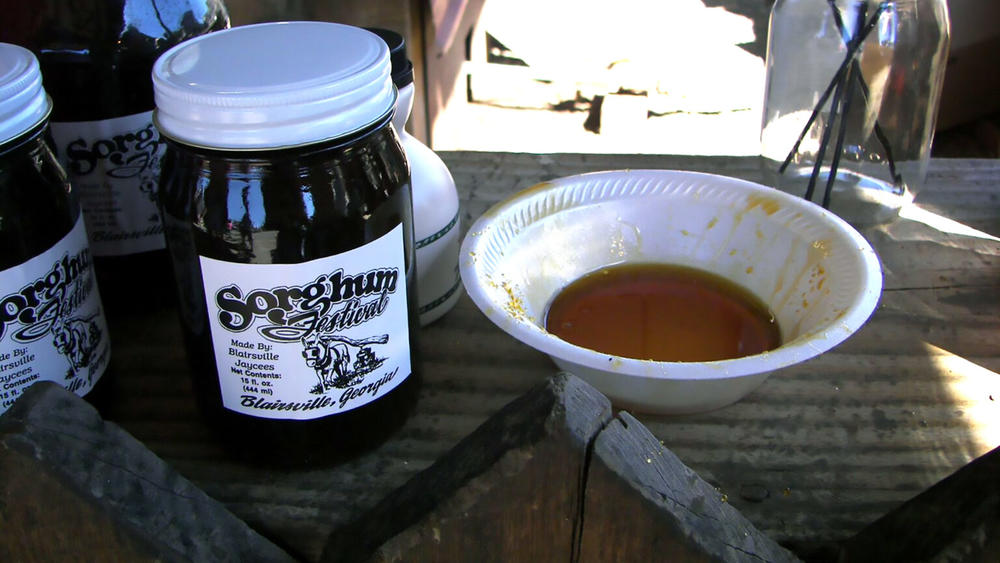
Caption
A jar of Sorghum syrup for sale at the Blairsville Sorghum festival in the North Georgia mountain town.
Credit: Bill Boemanns/Salvation South
Salvation South editor Chuck Reece’s father ate sorghum syrup almost every night. In his era, refined sugar was scarce on a North Georgia farm. There wasn’t a sugar bowl on most tables; instead, there was a jar of sorghum. These days, sorghum is a necessary element of Southern food and culture as Chuck explains in this week's commentary.

A jar of Sorghum syrup for sale at the Blairsville Sorghum festival in the North Georgia mountain town.
I saw it so many times when I was a kid. Over and over, night after night, my father ended almost every suppertime meal the same way.
He’d grab one of the few remaining biscuits, then cut a hunk of butter. If we were eating next door at my Uncle Efford’s and Aunt Mary’s house, the butter would be Mary’s homemade. She churned it by hand on her back porch with the cream from Efford’s milk cow.
Dad would put the butter on a plate and then grab a Mason jar filled with a gooey substance whose color was the deepest brown you could imagine.
And he’d pour some of that goo over the butter, then smash them both together through the tines of his fork. He would then dip his biscuit into that deep amber mixture, take a bite, and smile.
A sorghum butter biscuit. Daddy’s standard dessert.
Now, sorghum for centuries was a staple of the Southern table. Sorghum cane, a form of broomcorn, was cheap and easy to grow and very resistant to heat—which is a real good quality down here. And many folks couldn’t afford refined white sugar. But most folks could afford sorghum syrup.
When he’d feed it to me, I didn’t like it much. I was born late enough to get my sugar from grocery-store cereals and snacks. That stuff was pure sweetness. But sorghum was sweetness with a depth my young palate had a hard time with. Now, if you’ve never had sorghum syrup, its taste is unique. Sweet, yes. Sometimes a tangy undertone, depending on where the cane came from. A little nutty in flavor—and very earthy. You can almost taste dirt in it.
Like many of the good and pure country foods that I sneered at as a child, I developed a taste for sorghum years later. You want to give a sausage biscuit a kick you could never buy at a drive-through window? Open it up, put about a tablespoon of sorghum on the sausage, and then close the biscuit back up. Two bites and you’re bound for heaven.
I’ve been remembering sorghum lately because a young writer who grew up in the mountains, up in Blairsville, sent me a story about that little town’s annual fall sorghum festival. For many than a half-century, the Union County community gathers every fall to grind cane, squeeze out its juice and cook it down into syrup. Mikala Jones-Wall, the writer, grew up in a family that was part of the sorghum festival’s core group of organizers. Here’s what she wrote:
“The taste of sorghum is nostalgic. It nods toward a time when acquiring sugar wasn’t a quick errand because sugar wasn’t an option at all. Sorghum is the flavor of a region: Southern Appalachia. Using a biscuit to sop up sorghum and butter adds the perfect amount of sweet with just the right amount of bite.”
I read that and right away remembered my daddy. And I figured he’d be proud that I finally learned how to enjoy sorghum syrup.
Y’all can read Mikala’s story SalvationSouth.com.
Salvation South editor Chuck Reece comments on Southern culture and values in a weekly segment that airs Fridays at 7:45 a.m. during Morning Edition and 4:44 p.m. during All Things Considered on GPB Radio. You can also find them here at GPB.org/Salvation-South and please download and subscribe on your favorite podcast platform as well.
Salvation South editor Chuck Reece’s father ate sorghum syrup almost every night. In his era, refined sugar was scarce on a North Georgia farm. There wasn’t a sugar bowl on most tables; instead, there was a jar of sorghum. These days, sorghum is a necessary element of Southern food and culture as Chuck explains in this week's commentary.